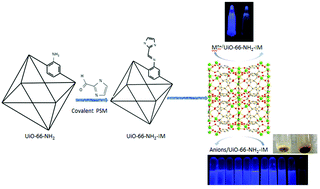A novel sensitive fluorescent probe of S2O82− and Fe3+ based on covalent post-functionalization of a zirconium(iv) metal–organic framework†
Abstract
A zirconium metallic organic framework UiO-66-NH2 has been synthesized and is further modified with imidazole-2-carboxaldehyde by a covalent post synthetic route which is based on a Schiff-base reaction. The as-prepared, functionalized MOF named UiO-66-NH2-IM is fully characterized. It retains its structural integrity during the PSM process and shows excellent luminescence and good fluorescence stability in water. It has also been further utilized as a sensitive fluorescent probe for sensing ions. The results show that UiO-66-NH2-IM can be developed into a highly selective and sensitive sensor for the detection of S2O82− (detection limit, 8.63 μM) and Fe3+ ions (detection limit, 4.95 μM) by fluorescence quenching of UiO-66-NH2-IM. All the possible mechanisms involved are discussed. Remarkably, it is the first covalent post-synthesized MOF to be developed as a colorimetric fluorescent sensor for the detection of S2O82− and Fe3+.



 Please wait while we load your content...
Please wait while we load your content...